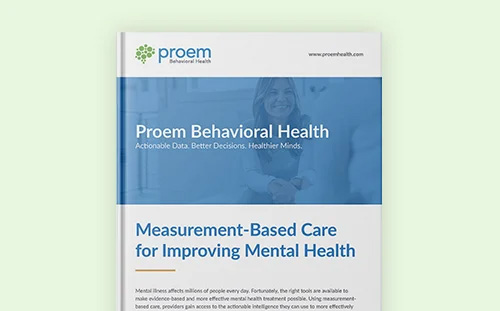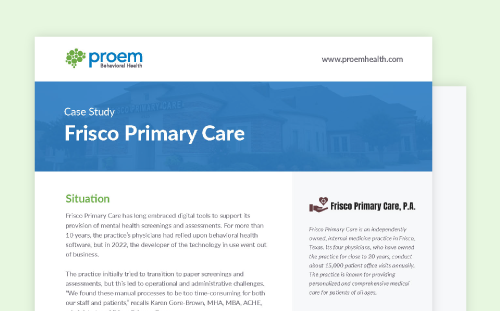Behavioral Health Integration in Primary Care: The Value & Revenue Opportunities

Discover the fundamentals of implementing a sound BHI program that can provide patient care improvements — and revenue potential — for your primary care practice.
Read the guide below or download your copy to take on the go.
Did you know that the average time between the onset of behavioral health symptoms and the beginning of treatment is 11 years?
Several factors contribute to this alarming statistic, but one of them is the complexity of finding behavioral health providers in our fragmented health care system.
But what if patients could receive behavioral health services right in their primary care provider’s office?
This is the idea behind a billing and service model called Behavioral Health Integration (BHI). Under this model, behavioral health is integrated into a primary care practice so patients can receive holistic care in a convenient setting. The benefits are significant, and there are proven models of care and purpose-built software solutions that primary care providers can adopt to implement BHI.
This guide will explore what BHI is, why primary care practices should consider it, and how you can begin making it a part of your practice.

Chapter 1:
Defining BHI
Behavioral health conditions, including mental illnesses and substance use disorders, don’t exist in a vacuum. They frequently impact physical health as well.
For example, behavioral health conditions may cause stress-related physical symptoms (e.g., insomnia, elevated blood pressure) or generally problematic health behaviors (e.g., self-harm, non-adherence to medication/treatment directions) that require both physical and behavioral health interventions.
That’s why many leaders in health care are now advocating for integrated behavioral health, or the practice of integrating care for medical/physical conditions with care for behavioral health conditions.
Also referred to as “integrated care,” “collaborative care” or “primary care behavioral health,” integrated behavioral health is a practice built around improving health outcomes for the whole patient, both mind and body.
The Core Components of Integrated Behavioral Health: Key Principles
Arising from an increased focus on “whole-person care,” integrated behavioral health care recognizes that medical and behavioral health factors both impact a person’s overall health. In practice, this means increasing coordination and communication between clinicians with differing areas of focus.
While it's most common to find Behavioral Health Integration in primary care settings, it can also occur in specialty settings, such as obstetrics, oncology, pediatrics and others.
What is an example of integrated health care?
To get an idea of how integrated health care may work, imagine a patient arriving at their annual wellness exam with complaints of a lack of energy, trouble sleeping and a decline in interest in hobbies. These are all widely recognized symptoms of depression.
In a traditional model of care, the primary care physician (PCP) would write the patient a referral for behavioral health care, forcing them to seek an external provider.
However, a PCP working in an integrated practice would be able to use a screening tool to confirm that depression is likely, knowing they could be reimbursed for providing that service. They would then share that information with a behavioral health clinician connected to their practice, and their office would facilitate appointment scheduling. As the patient embarks on a treatment plan with the behavioral health provider, the PCP will be aware of it and will be able to support its progress over time.
Nearly
50%
of the U.S. population reported experiencing harm
to their mental health amid the COVID-19 crisis.
Why is Behavioral Health Integration in primary care so important?
One of the most common entry points into behavioral care is via a PCP. In fact, a 2021 cross-sectional study of medical expenditures found that approximately 40% of office visits for mental health concerns occur in a primary care office, and PCPs write 47% of prescriptions for mental illness. Nearly half the U.S. population reported experiencing harm to their mental health amid the COVID-19 crisis, and the long-term effects of COVID continue to drive increased need for mental health services.
With PCPs often among the first people to recognize signs of behavioral health issues, it’s important they feel empowered to guide patients on their treatment journey.
What are the three stages of integrated behavioral health care?
The Medical Group Management Association identifies three stages of integrated behavioral health care:
1 Coordinated.
Behavioral health providers and PCPs work at physically separate facilities and have separate health record systems. Communication between providers is rare, usually only occurring to request specific information.
2 Co-located.
Behavioral health providers and PCPs deliver care in the same physical location or practice. Patient care is often still siloed to areas of expertise, but providers’ proximity may facilitate occasional meetings.
3 Fully integrated.
Behavioral health providers and PCPs function as a team, working together in the same physical space to design and implement a patient care plan. Providers view the clinical operation as a single system treating the whole person.
The fully integrated stage is the most mature and should be the goal of providers adopting integrated behavioral care.
Does “integrated behavioral health care” mean the same thing as “Behavioral Health Integration” (BHI)?
In short, no, they are not the same thing — although they are closely related.
As discussed above, integrated behavioral health is the concept of integrating behavioral health into primary care.
“Behavioral Health Integration” (BHI), on the other hand, is a medical billing term. It refers to a specific program that reimburses practitioners who provide services associated with delivering integrated behavioral health care.
Understanding the Integrated Behavioral Health Model in Primary Care
Medicare began reimbursing BHI codes on Jan. 1, 2018. Some private insurers also cover BHI. However, BHI is still new territory for many PCPs.
Some of the challenges PCPs face concerning BHI include:
-
Insufficient time to delve into behavioral issues due to high patient volumes
-
A lack of access to tools for tracking and treating behavioral health issues
-
A shortage of resources for efficiently coordinating with a patient’s other health care providers
-
Not understanding how to bill for BHI
-
Feeling unprepared to manage severe cases
However, many PCPs are taking steps to overcome these challenges and embrace the integrated behavioral health model in primary care.
What is the major role of the primary care provider working within an integrated behavioral health care model?
As the term suggests, PCPs are often a patient’s primary entry point into the wider health care system. That positions them at the nexus of primary care and behavioral health. In an integrated behavioral health care setting, they can provide:
-
Patient education
-
Preliminary investigation into whether behavioral health factors may cause or contribute to physiological conditions
-
More frequent “check-ins” to evaluate behavioral health treatment adherence
-
Referrals to a specialist for further diagnosis and/or treatment
How can PCPs effectively implement the integrated primary care behavioral health model?
The American Psychological Association (APA) identifies two widely adopted integrated behavioral health models in primary care: the primary care behavioral health model (PCBH) and the collaborative care model (CoCM).
PCBH, also referred to as the primary care behaviorist model, involves a licensed behavioral health professional working alongside a PCP to provide coordinated care.
CoCM is based on a chronic care management approach and involves providing psychiatric services to primary care patients with specific chronic mental illnesses. Services are provided by a team comprised of a PCP, a care manager and a consulting psychiatrist.
While these models are most common, the APA also notes the importance of taking an approach that supports the unique needs of specific patient populations and accounts for the nuances of the environment in which the primary care team operates.

Chapter 2:
Benefits of BHI
Integrated behavioral health represents such a significant paradigm shift that many primary care physicians feel hesitant about adopting it. Understanding the goals and benefits of Behavioral Health Integration (BHI) can help physicians recognize how adopting it could benefit them and their practice.
What Are the Goals of Integrated Behavioral Health Care?
1 Foster Collaboration Between Behavioral Health and Primary Care
Often, physical and behavioral conditions affect each other and must be treated in tandem for the best results. However, standard approaches to health care typically separate behavioral health care from primary care, forcing patients to settle for a fractured, less effective approach.
One of the goals of integrated behavioral health care is to open the lines of communication between primary care and behavioral health practitioners, fostering collaborative relationships and mutual support. This can ultimately help both primary care and behavioral health providers treat patients more effectively.
2 Promote Better Health Outcomes
Evidence suggests that separating primary care and behavioral health care results in quantifiably worse health outcomes.
For one thing, many people referred to behavioral health professionals by their primary care provider (PCP) don’t follow through and ultimately don’t receive care. This suggests that if patients could receive behavioral health care in their PCP’s office, rates of care would go up.
When patients do visit specialists, data shows that siloed health care still results in worse outcomes. For example, a study by the American Psychiatric Association found that overall spending for medical patients with comorbid mental health or substance abuse issues is 2.5 to 3.5 times higher than for those with only medical conditions and that life expectancy for people with major mental health diagnoses is 7 to 24 years shorter than those without such diagnoses.
It doesn’t need to be this way. A review of 79 trials of collaborative care found the integrated behavioral health care model significantly improved outcomes for patients with depression and anxiety. Meanwhile, a hospital in Salt Lake City found that integrating behavioral health into primary care saved $115 per patient per year and resulted in 76% fewer primary care visits.
A hospital in Salt Lake City found that integrating
behavioral health into primary care resulted in
76%
fewer primary care visits.
3 Provide More Preventive Behavioral Health Screening
The medical community broadly recognizes the importance of preventive screenings so PCPs can catch medical ailments early and treat them before they become more serious. The same principle can be applied to behavioral health but rarely is.
A lack of preventive behavioral health care means there’s often a lengthy delay between the initial onset of a behavioral health condition and when a patient starts seeking treatment. During that time, patients suffer from their symptoms and may see their conditions worsen.
Integrated behavioral health can ensure that PCPs have the proper tools and support needed to make behavioral health screening a routine part of preventive care.
4 Address Behavioral Health Concerns Quicker
Often, scheduling appointments with behavioral health specialists can take several weeks due to scheduling issues, insurance concerns and other delays.
A key goal of integrated behavioral health care is to help patients address behavioral health concerns in a timelier manner, even getting the treatment process started right in their PCP’s office.
What Are the Benefits of Integrated Behavioral Health Care?
Research has shown between 68% and 75% of patients with a diagnosed behavioral health condition also have at least one other medical condition. Increasing access to integrated behavioral health gives these patients more opportunities to receive effective, holistic care.
Some additional benefits of integrated behavioral health care include:
-
Behavioral health symptoms are identified earlier, leading to faster interventions.
-
The stigma of receiving behavioral health treatment may go down if screening becomes routine at PCP visits.
-
Practitioners can coordinate the care they provide to address the behavioral health factors that may cause a patient to struggle to manage a medical condition.
-
Patients who receive behavioral health treatment in primary care use 16% less health care services overall, while patients who do not receive behavioral health treatment increase their use of health care services by 12%, according to the Primary Care Collaborative.
-
Patients and providers alike are more satisfied. A survey by Families, Systems & Health showed a satisfaction rate of more than 97% for integrated behavioral health programs, coupled with a 90% reduction in personal stress levels for participating PCPs.
Research has shown between
68%–75%
of patients with a diagnosed behavioral health condition
also have at least one other medical condition.

Chapter 3:
Trends and Developments in BHI
Increasingly, industry leaders are advocating for value-based care in which patients pay for outcomes, rather than fee-for-service models. Integrating behavioral health services into primary care can pave the way toward adopting this model.
Here’s a closer look at value-based care, as well as other emerging care models supported by integrated behavioral health.
How Do Integrated Behavioral Health Services Support the Transition to Value-Based Care?
Today, most health care services are reimbursed on a fee-for-service basis, meaning a practice is paid for each discreet service it delivers. This has led to concerns that practices are incentivized to provide services that may not be necessary.
In response, policymakers and payer stakeholders have begun encouraging practices to instead adopt value-based care models, also known as alternative payment models. In these arrangements, practices are reimbursed – sometimes up front – based on overall outcomes like quality, cost and equity of care.
Analysis from the Health Care Payment Learning & Action Network shows about 41% of payments in the United States flow through value-based care models and 59% through fee-for-service models. However, primary care physicians are lagging, according to the Commonwealth Fund, with 71% of PCPs receiving revenue from fee-for-service models.
Behavioral Health Integration as a Care Management Service
Behavioral health has similarly been on the outside looking in when it comes to value-based care. A MedCity News commentary identifies several factors that contribute to this, including low reimbursement rates, health insurance carve-outs and limited parity for behavioral health in comparison to other specialties. As a result, most behavioral health services are paid for out of patients’ pockets.
This limits who has access to behavioral health care, forcing those who cannot pay out of pocket to compete for fewer providers or go without. In 2017, the Centers for Medicare & Medicaid Services (CMS) took steps to remedy this by introducing billing codes that PCPs can use to bill for BHI services. These codes fit into two categories: general BHI services and Collaborative Care Management services.
Reimbursement for BHI services can help PCPs shift to value-based payment models while supporting greater access to behavioral health for all their patients.
Behavioral Health’s Role in Value-based Primary Care
Addressing behavioral health in primary care has been linked to improved clinical outcomes and cost savings. Several characteristics of the Making Care Primary model that CMS introduced in 2023 are poised to help practices generate more revenue while transitioning to value-based primary care:
-
Upfront, consistent payments that don’t depend on the volume of services provided
-
Performance improvement bonuses based on depression remission, as measured in depression screenings
-
The ability to take on downside financial risk incrementally
-
The option to seek additional funding for care coordination
-
Specialized technical assistance and educational resources
-
A 10-year implementation period to provide practices with a softer landing
The Role of Measurement in Value-based Care
Whether Medicare, Medicaid, or private insurers administer a value-based primary care program measurement is critical for allowing both providers and payers to track whether patients are being treated, as well as whether patients’ symptoms are improving.
Tracking relevant metrics has the twofold benefit of making practices accountable for providing high-quality care and enabling payers and providers to set shared incentives.
The Collaborative Care Model and Integrated Care: 7 Things to Know
Though the concept is straightforward, the terminology around various models of care is quite nuanced. Here, we explain the precise definitions of the Collaborative Care Model, Collaborative Care Management, integrated behavioral health and Behavioral Health Integration (BHI).
1 What is the difference between integrated care and collaborative care?
In simple terms, one is a concept, and the other is a framework. Integrated care is the concept of providing care for medical and behavioral health conditions in one setting.
The Collaborative Care Model is a framework for how PCPs and behavioral health practitioners can implement care plans based on evidence-based guidelines.
2 The Collaborative Care Model in primary care has five core principles.
More than a decade ago, industry stakeholders convened to draft the Collaborative Care Model as a framework for implementing integrated behavioral health. The framework has five principles:
-
Patient-centered team care that emphasizes patient engagement and a care plan designed by both primary care and behavioral health practitioners.
-
Population-based care designed to be appropriate for the population of patients the care team works with.
-
Measurement-based treatment to track progress toward specific goals and outcomes.
-
Evidence-based care that uses science-backed treatments.
-
Accountable care as reflected in a value-based reimbursement model, which emphasizes care quality and clinical outcomes over the volume of services provided.
3 There’s also a difference between integrated behavioral health and Behavioral Health Integration.
It’s worth restating that there’s a subtle difference between integrated behavioral health and Behavioral Health Integration (BHI). While integrated behavioral health describes a general concept, BHI specifically refers to a set of services defined by the Centers for Medicare & Medicaid Services that primary care physicians can be reimbursed for providing.
4 If that’s not enough, there’s also Collaborative Care Management.
General BHI services are billed under one Current Procedural Terminology (CPT*) code (CPT 99484). This code covers services like initial assessments and coordinating treatment. Practitioners without specialized training in behavioral health training can deliver these services.
CMS has also established a set of CPT codes for Collaborative Care Management. These services are performed by a psychiatric consultant or a designated behavioral health care manager and can include joint care planning, caseload review, administration of evidence-based interventions and follow-up with patients.
Collaborative Care Management is distinctive of the Collaborative Care Model (though, at the risk of further confusion, both may be abbreviated as either CCM or CoCM). While the Collaborative Care Model is a framework of care, Collaborative Care Management refers to specific billing codes.
5 Integrated care and collaborative care aren’t interchangeable.
BHI and CoCM billing codes are used in different scenarios. An FAQ from the American Psychiatry Association about reimbursement criteria for Collaborative Care Management (CoCM) billing codes notes three key distinctions:
-
CoCM care planning covers all health issues, while BHI focuses on more systematic behavioral health care management.
-
CoCM requires the use of certified EHR technology, while BHI doesn’t.
-
BHI services are provided solely by the billing practitioner, while it’s expected that a team of practitioners will deliver services covered by CoCMs.
6 The Collaborative Care Model is an attractive option for Medicaid Health Homes.
Under the Affordable Care Act, states have the option to create Health Homes to help Medicaid beneficiaries manage chronic conditions, including “serious and persistent mental health conditions.”
A research brief from the Center for Health Care Strategies suggests the Collaborative Care Model’s whole-person care focus is a good fit for the Medicaid Health Homes model, as it “demonstrate[s] higher effectiveness than usual care” while also saving $6.50 for every $1 spent.
7 The Collaborative Care Model is effective in treating behavioral health in diverse patient populations.
The Center for Health Care Strategies further notes that using the Collaborative Care Model in primary care positively impacts various vulnerable populations, including people from underserved demographics and patients with chronic diseases. Similarly, a 2022 paper in Medicine points to the benefits of bringing the Collaborative Care Model to women’s health, geriatric health, and even college campuses.

Chapter 4:
Opportunities for Reimbursement
Behavioral Health Integration, as the Centers for Medicare & Medicaid Services (CMS) defines it, involves specific requirements for what services can be provided under which billing codes, by which members of the care team, and for what duration and frequency.
Here’s a closer look at what primary care providers should know to get reimbursed for integrated behavioral health.
Behavioral Health Integration: CMS Requirements & Expectations
CMS defines conditions eligible for BHI as “any mental, behavioral health, or psychiatric condition that the billing practitioner treats, including substance use disorders.”
Patients with pre-existing conditions qualify, and those conditions don’t necessarily need to be primarily managed by the billing practitioner.
As mentioned above, CMS will reimburse practitioners for two types of Behavioral Health Integration Services. One is general services, which consist of assessment and monitoring, care plan revision, and ongoing engagement with a care team member.
The other is services that fall under Collaborative Care Management, a set of CMS-defined integrated services performed by a psychiatric consultant or behavioral care manager.
Supporting BHI: The Role of the Integrated Behavioral Health Clinician
The cornerstone of integrated behavioral health is an interdisciplinary care team operating out of one trusted setting. CMS identifies the following care team members under the Collaborative Care Model.
-
Treating or billing practitioner. This is typically a primary care provider, though it may be a specialist in some cases.
-
Behavioral health care manager. This provider has formal training in behavioral health in the disciplines of social work, nursing or psychology. They work under the direction of the billing practitioner.
-
Psychiatric consultant. This is a medical provider qualified to provide psychiatric diagnoses and treatments.
For practices only billing under general BHI, CMS more loosely defines the care team as consisting of the patient, the billing practitioner and additional clinical staff.
Aligning with CMS Guidelines for Integrated Mental Health Services
Recent regulatory changes should make it easier for practices to provide integrated health services. Under the 2023 Medicare Physician Fee Schedule Final Rule, services for behavioral health are now allowed under general rather than direct supervision.
Per the APA, this means,“Behavioral health services can be performed under the direction and control of the physician or [non-physician practitioner], but they do not need to be physically present.”
The second important change is the introduction of HCPCS code G0323, which allows for an expanded care team regardless of the formal model of care being offered.
CMS has clear expectations for practices that aim to bill for BHI. These requirements offer practices a blueprint for building an effective, multidisciplinary care team.
What Is the CPT Code for Behavioral Health Integration?
Initially, CMS reimbursed general BHI services under CPT code 99484 and Psychiatric Collaborative Care Management (CoCM) services under CPT codes 99492, 99493 and 99494.
As demand for integrated behavioral health services increased, CMS also introduced Health Care Common Procedure Coding System (HCPCS) codes G2214, G0323 and G0511. (HCPCS codes are a subset of CPT codes.)
Each CPT and HCPCS code comes with different requirements, and it’s important for practitioners to know which codes are appropriate for the specific services they provide.
Understanding the Collaborative Care Billing Codes
General BHI services are billed under CPT code 99484: Care management services for behavioral health conditions, at least 20 minutes of clinical staff time, directed by a physician or other qualified health care professional, per calendar month.
This code can cover services like regular assessment and monitoring, care plan creation and revision, and collaboration with other members of the care team.
Meanwhile, there are three CPT codes for Psychiatric CoCM services:
99492: Initial Psychiatric Collaborative Care Management, first 70 minutes in the first calendar month of behavioral health care manager activities, in consultation with a psychiatric consultant, and directed by the treating physician or other qualified health care professional.
99493: Subsequent Psychiatric Collaborative Care Management, first 60 minutes in a subsequent month of behavioral health care manager activities, in consultation with a psychiatric consultant, and directed by the treating physician or other qualified health care professional.
99494: Initial or subsequent Psychiatric Collaborative Care Management, each additional 30 minutes in a calendar month of behavioral health care manager activities, in consultation with a psychiatric consultant, and directed by the treating physician or other qualified health care professional. (This code should be reported in conjunction with 99492 or 99493.)
While CPT codes 99492 and 99484 sound similar, remember that services billed to CPT code 99492 must be delivered as part of a Psychiatric CoCM model, while those billed to CPT code 99484 may be delivered as part of any care model.
CMS documentation indicates providers shouldn’t bill general BHI and CoCM CPT codes in the same calendar month for a single Medicare beneficiary. However, CMS advises “it may be appropriate” to report multiple codes over the course of several months.
In 2018, CMS also introduced CPT codes for BHI services provided by federally qualified health centers (FQHCs) and rural health centers. HCPCS code G0511 is for general services, while HCPCS code G0512 is for Psychiatric CoCM services. Use of these codes will reimburse providers at a higher rate, reflecting the value of providing behavioral health services in rural and underserved areas.
A New Collaborative Care Billing Code for Shorter Consultations in 2021
The pandemic led to an increased need for behavioral health care, which, in turn, resulted in longer waitlists and greater practitioner burnout, according to an American Psychological Association survey.
In 2021, in response to this increased demand, CMS introduced HCPCS code G2214: Initial or subsequent Psychiatric Collaborative Care Management, first 30 minutes in a month of behavioral health care manager activities, in consultation with a psychiatric consultant, and directed by the treating physician or other qualified health care professional.
According to CMS, this billing code is intended to capture shorter increments of time spent with a patient under Psychiatric CoCM services, allowing patients to achieve quicker results while reducing workloads for practitioners.
Changes to the CMS Mental Health Services Billing Guide 2023
In 2023, CMS further expanded access to care with a CPT code for BHI services billed by practitioners who are not primary care providers.
The new HCPCS code is G0323: Care management services for behavioral health conditions, at least 20 minutes of clinical psychologist or clinical social worker time, per calendar month.
HCPCS code G0323 is similar to CPT code 99484 in the sense that both are intended for general BHI services, not for Psychiatric CoCM services. This new code allows psychologists to be reimbursed for their time as members of an integrated behavioral team, even if they’re not operating under the CoCM model.
What the CPT Code 99484 Reimbursement Means for Your Bottom Line
CPT code 99484 reimbursement, which covers care management for general BHI services, lets practices integrate behavioral health and primary care to provide valuable services in a familiar care setting – and generate additional revenue for the work they’re already doing by billing Medicare or select commercial insurances for BHI reimbursement.
A Closer Look at CPT 99484 Billing Guidelines
CMS has identified several core components of general BHI services that meet the criteria for CPT code 99484 reimbursement.
-
Initial assessment via applicable validated clinical rating scales to assess a patient’s likelihood of a behavioral health diagnosis.
-
Systematic assessment and monitoring by administering applicable validated clinical rating scales throughout the treatment period.
-
Joint care planning with the patient to help develop a treatment plan and revise that treatment plan if necessary.
-
Facilitation and coordination of behavioral health treatment with the care team.
-
A continuous relationship with an appointed member of the care team to support long-term patient outcomes.
The billing practitioner may also manage a patient’s chronic and/or comorbid medical conditions, though this isn’t required under CPT 99484 billing guidelines.
How the CPT 99484 Reimbursement Rate Can Drive Practice Revenue
Practitioners can bill general BHI services once per calendar month per patient. The CPT code 99484 average Medicare reimbursement rate for 2023 was $43.04 per encounter, which can add up over time.
There are several billing codes for Chronic Care Management, some of the most common being CPT code 99490 (the first 20 minutes of services provided in a calendar month to coordinate care and support patient accountability for patients with non-complex CoCM) and CPT code 99439 (each additional 20 minutes per calendar month). ThoroughCare estimates that the CPT code 99490 reimbursement rate is $62.69 and the CPT code 99439 reimbursement rate is $47.44.
More Options for CMS Reimbursement for General BHI
HCPCS codes offer additional options for qualified practitioners to generate revenue from BHI for their practices.
One is HCPCS code G0323, introduced in 2023 to cover services furnished by a clinical psychologist or clinical social worker, which allows for the expansion of integrated care teams. HCPCS code G0323 covers 20 minutes of services per calendar month and reimburses at a rate of $43.04.
Another is HCPCS code G0511, which covers the same services and billing practitioners as both CPT code 99484 and HCPCS code G0323 but applies specifically to FQHCs operating in traditionally underserved areas. The reimbursement rate for this code is higher, at $77.94, to help FQHCs recoup the cost of implementing value-based care.

Chapter 5:
How Technology Can Support BHI
The benefits of offering integrated behavioral health in primary care are equal parts clinical, operational, and financial – it helps practices reduce overall utilization, increase revenue and improve patient satisfaction.
Behavioral Health Integration (BHI) is not without its challenges, though. The American Medical Association’s Moving Medicine podcast describes the additional workflows needed to make integrated care work, including increased patient screening, care planning and follow-up, and more purposeful quality and financial reporting.
However, these complexities can be addressed with the help of purpose-built software.
How Software Supports Integrated Behavioral Health in Primary Care
Integrating behavioral health with primary care requires several functional transitions, and technology can be a key enabler of these. Here’s a look at the role technology plays in integrated behavioral health.
Technology’s Role in Supporting BHI
Electronic health record (EHR) systems and their add-on components are cornerstones of health care technology, and this remains true for practices using BHI. EHR systems can track patients through the behavioral health care journey, coordinate referrals and other forms of communication across the care team, support patient education and provide automated reminders about follow-up care.
Additional health care software can provide additional forms of critical support, including decision support for PCPs, self-management options for patients, information exchanges and communication between providers, and tailored support for medication-assisted treatment.
Meanwhile, the American Medical Association outlines telehealth’s potential to make integrated behavioral health more accessible by allowing practitioners to provide screening, education, treatment and care coordination virtually.
Another key benefit of what AMA describes as “digitally enabled BHI” is the potential to raise the standard of care by integrating standard measurement tools into provider- and patient-facing technologies. Ongoing measurement allows practices to track patients’ treatment progression in a standardized way and to continuously refine the quality of care provided.
Improved Outcomes and Increased Reimbursement
Providing integrated behavioral health in primary care has been linked to lower overall care costs for patients with diagnoses of both behavioral health and chronic health conditions, as well as improved care coordination. Thanks to BHI codes, providers can transition to value-based care while getting properly reimbursed.
Supportive technologies can help providers more easily adopt the workflows needed to enjoy these benefits.
Integrated Behavioral Solutions for Primary Care: Three Things to Consider
Achieving the goals of integrated behavioral health requires end-to-end technologies for identifying patients who would benefit from behavioral health services, coordinating care, measuring outcomes and documenting encounters for appropriate reimbursement.
As you evaluate options for clinical workflow software to support integrated behavioral health, keep these considerations top of mind.
1 Increase the impact: Software supports earlier identification and better care coordination.
Meeting patients’ needs using existing clinical applications can be a tall order, as most EHR solutions have a disjointed library of screening tools that can be cumbersome to sort through. Many EHRs also aren’t designed to document behavioral health treatment and outcomes.
However, with the right software, practices can quickly screen patients for multiple common conditions, obtain a greater understanding of how behavioral health and physical health intersect, and more efficiently formulate treatment plans.
Finally, a tool that leverages application programming interfaces (APIs) to integrate with your EHR can lead to more effective information sharing and care coordination.
2 Support primary care: Behavioral health measurement and tracking results in improved follow-up and continuity of care.
Using software to assist with assessments and the formulation of treatment plans has the added benefit of helping practices embed these assessments within clinical workflows without requiring providers to launch another application.
From there, tools such as symptom monitors, severity measurement scales and functional impairment scales can further help providers gain a full view of a patient’s progress. This has the twofold benefit of promoting informed decision-making and supporting reporting requirements for value-based care.
3 Drive value: Solutions provide documentation for reimbursement and quality reporting.
Software can generate documentation for integrated behavioral health services, and proper documentation is a cornerstone of measurement-based care. It also guarantees that providers can be reimbursed for the relevant BHI codes.
Documentation also offers a record of medical necessity, which is valuable for streamlining the prior authorization process with payers.
Finally, documentation supports a practice’s efforts to transition to value-based care, which emphasizes the value of services provided as opposed to the volume. A thorough record of diagnoses, symptoms and outcomes helps demonstrate that your practice is providing the right services to the right patients at the right time.
How to Successfully Bring BHI to Your Practice
While it’s clear that integrated behavioral health and value-based care benefit patients and providers alike, adopting any new practice is bound to be somewhat challenging without the right tools or workflows.
Software that’s purpose-built to support integrated behavioral health can make the transition smoother and improve the experience for practices as well as their patients. For example, the clinical workflow software from Proem Behavioral Health® provides a complete workflow for Behavioral Health Integration that supports primary care practitioners in screening, monitoring and managing patients’ behavioral health care.
With Proem’s clinical workflow solution, practitioners also gain support for maintaining documentation and accurately billing for their services. This, combined with its end-to-end care workflow, makes it the ideal tool to help practitioners make integrated behavioral health a standard part of their practice. To learn more about how we can support your BHI services and revenue growth, book a meeting today!
* CPT is provided "as is" without warranty of any kind, either expressed or implied, including but not limited to, the implied warranties of merchantability and fitness for a particular purpose. No fee schedules, basic unit, relative values or related listings are included in CPT. The AMA does not directly or indirectly practice medicine or dispense medical services. The responsibility for the content of this file/product is with Proem and no endorsement by the AMA is intended or implied.

Discover the fundamentals of implementing a sound BHI program that can provide patient care improvements — and revenue potential — for your primary care practice.
Read the guide below or download your copy to take on the go.







